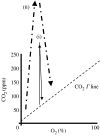Methane, oxygen, photosynthesis, rubisco and the regulation of the air through time
- PMID: 18487133
- PMCID: PMC2606774
- DOI: 10.1098/rstb.2008.0057
Methane, oxygen, photosynthesis, rubisco and the regulation of the air through time
Abstract
Rubisco I's specificity, which today may be almost perfectly tuned to the task of cultivating the global garden, controlled the balance of carbon gases and O(2) in the Precambrian ocean and hence, by equilibration, in the air. Control of CO(2) and O(2) by rubisco I, coupled with CH(4) from methanogens, has for the past 2.9 Ga directed the global greenhouse warming, which maintains liquid oceans and sustains microbial ecology.Both rubisco compensation controls and the danger of greenhouse runaway (e.g. glaciation) put limits on biological productivity. Rubisco may sustain the air in either of two permissible stable states: either an anoxic system with greenhouse warming supported by both high methane mixing ratios as well as carbon dioxide, or an oxygen-rich system in which CO(2) largely fulfils the role of managing greenhouse gas, and in which methane is necessarily only a trace greenhouse gas, as is N(2)O. Transition from the anoxic to the oxic state risks glaciation. CO(2) build-up during a global snowball may be an essential precursor to a CO(2)-dominated greenhouse with high levels of atmospheric O(2). Photosynthetic and greenhouse-controlling competitions between marine algae, cyanobacteria, and terrestrial C3 and C4 plants may collectively set the CO(2) : O(2) ratio of the modern atmosphere (last few million years ago in a mainly glacial epoch), maximizing the productivity close to rubisco compensation and glacial limits.
Figures







References
-
- Ashida H, Danchin A, Yokota A. Was photosynthetic RubisCO recruited by acquisitive evolution from Rubisco-like proteins involved in sulfur metabolism? Res. Microbiol. 2005;16:611–618. doi:10.1016/j.resmic.2005.01.014 - DOI - PubMed
-
- Brocks J.J, Buick R, Summons R.E, Logan G.A. A reconstruction of Archean biological diversity based on molecular fossils from the 2.78 to 2.45 billion-year-old Mount Bruce Supergroup, Hamersley basin, Western Australia. Geochim. Cosmochim. Acta. 2003;67:4321–4335. doi:10.1016/S0016-7037(03)00209-6 - DOI
-
- Buick, R. 2008 When did oxygenic photosynthesis evolve? Phil. Trans. R. Soc. B363, 2731–2743. (doi:10.1098/rstb.2008.0041). - DOI - PMC - PubMed
-
- Caldeira K, Kasting J.F. Susceptibility of the early Earth to irreversible glaciation caused by carbon dioxide clouds. Nature. 1992;359:226–228. doi:10.1038/359226a0 - DOI - PubMed
-
- Canfield D.E. The early history of atmospheric oxygen. Annu. Rev. Earth Planet. Sci. 2005;33:1–36. doi:10.1146/annurev.earth.33.092203.122711 - DOI
MeSH terms
Substances
LinkOut - more resources
Full Text Sources
Miscellaneous
